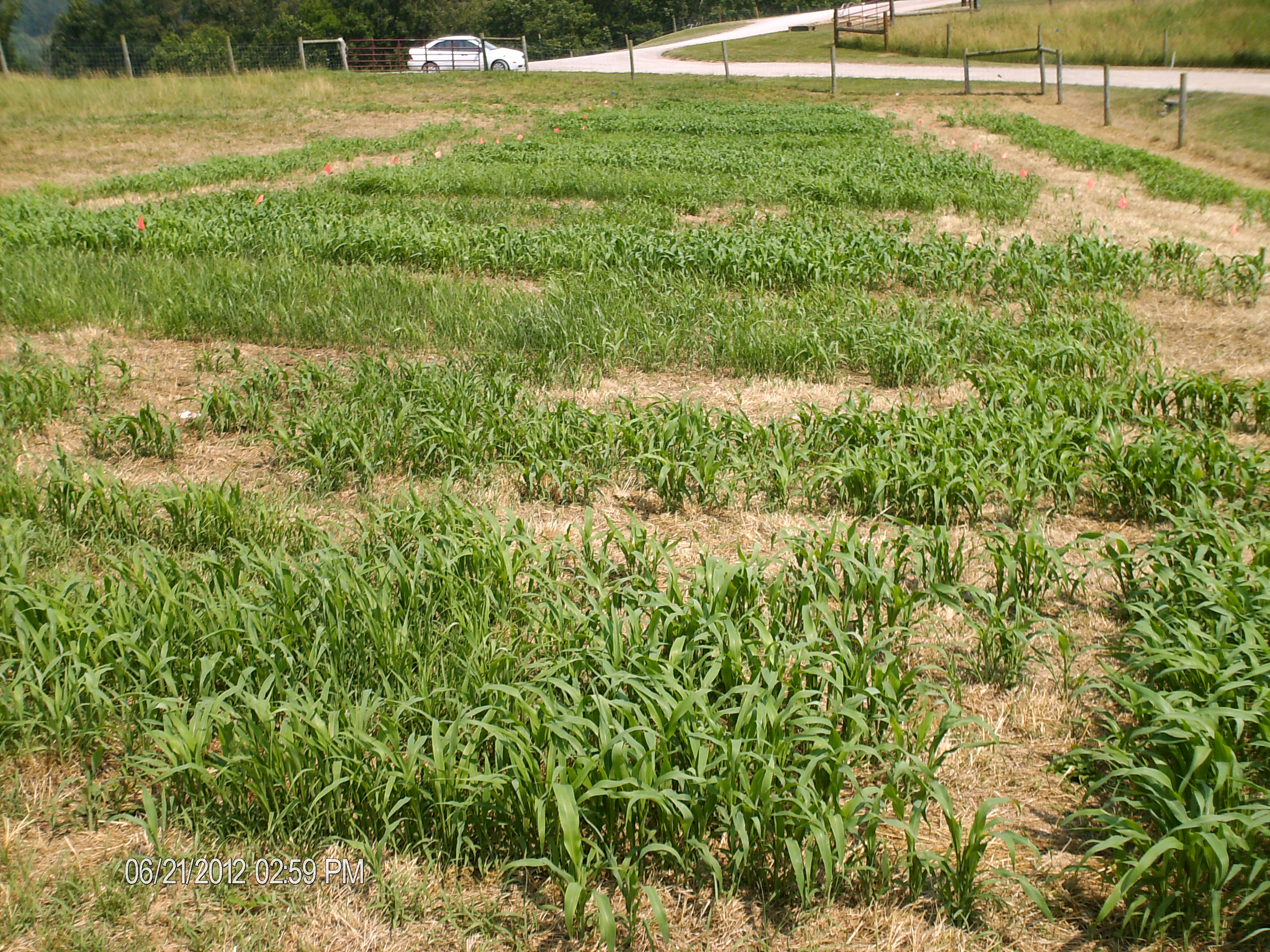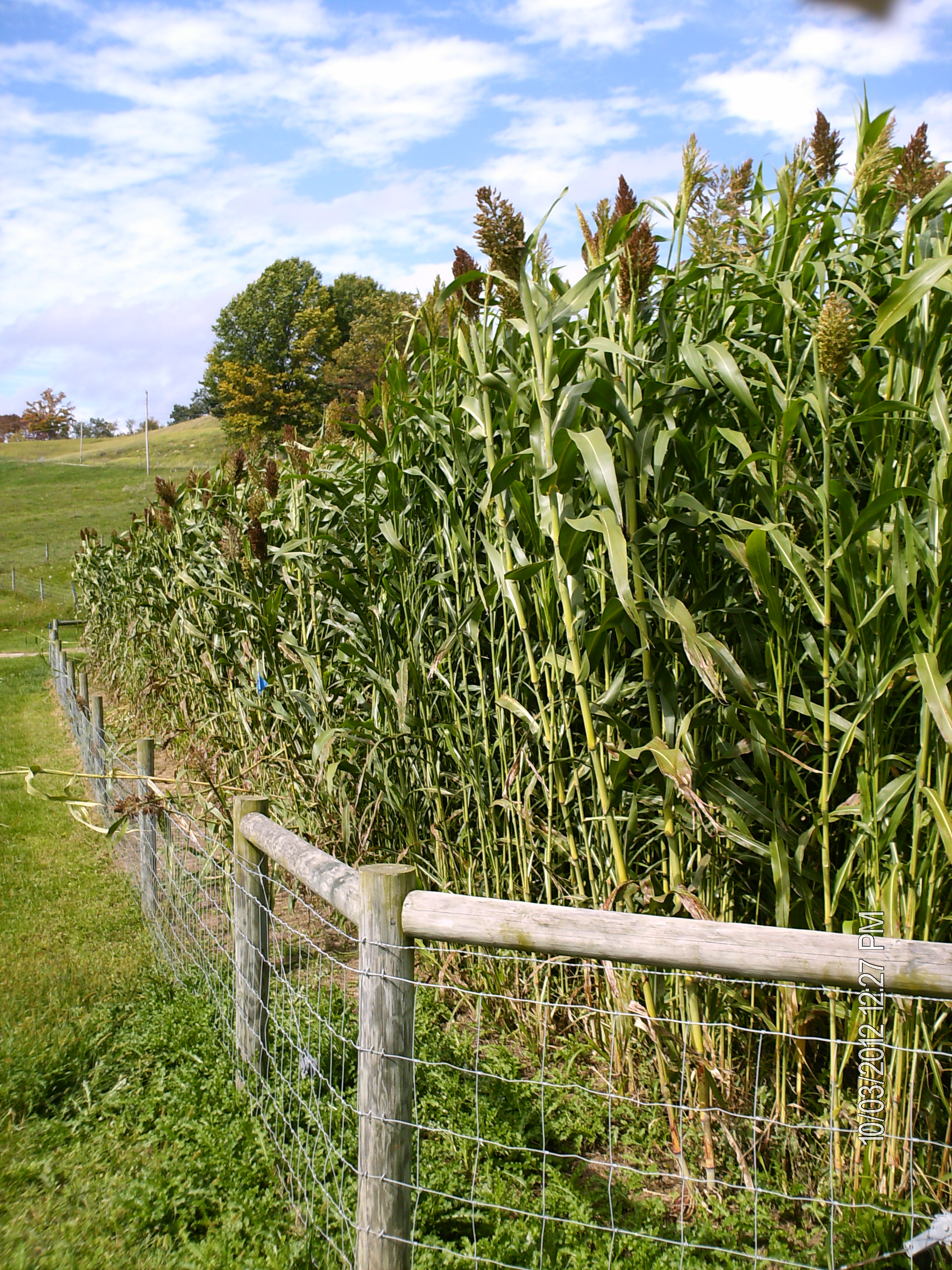Journal of the NACAA
ISSN 2158-9429
Volume 7, Issue 1 - May, 2014
Sorghum-Sudangrass for Feed and Fuel
- Penrose, C., Associate Professor and Extension Educator, Ohio State University Extension
Little, R.L., Associate Professor and Extension Educator, Ohio State University Extension, Guernsey Co.
ABSTRACT
Sorghum-sudangrass hybrids are options for grazing livestock and may be a possibility for biomass production. Four varieties were evaluated in a trial in 2012 for yield, quality and energy value. Yield and quality were comparable to corn silage. Yields ranged from 26,253-43,346 lbs. dry matter per acre. There were significant differences in crude protein (6.32-9.00%) and neutral detergent fiber (61.42-67.57%). The energy levels ranged from 7206-7535 BTU’s per pound of dry matter comparative to switchgrass. The varieties have potential as summer forage and a biomass crop to provide renewable energy.
Introduction
Sorghum-sudangrass hybrids are warm-season annual forages that look like sudangrass in growth but are generally taller, with larger stems and leaves (Barker, et al., 2005). They are bred for productivity, high yields and can grow to 15 feet in height without lodging. Sorghum-sudangrass can be grazed, green chopped, baled for hay, silage, haylage, cover and green manure (Janick, Schery, Woods, Ruttan, 1974). Another emerging option is to use this summer annual as a biomass fuel. Renewable energy has become recognized as a viable source of fuel, and sorghum-sudangrasshas potential for use in cellulosic ethanol production, and is an option as a renewable fuel. A concern for farmers considering biomass production has been the lack of a guaranteed market at a fair price for the sale of these forages. A crop that can have multiple options for farmers and be used for biomass production may increase demand for renewable energy crops. The purpose of this study was to evaluate these varieties for quality, energy value for biomass production and yield as when utilizing as a biomass crop.
Methods
There were four varieties used in the trial from Chomatin Inc. of Lubbock, TX. The trial was located at the Ohio Agriculture Research and Development Center, Eastern Ohio Research Station in Noble County, Ohio. The soil is a Vandalia-Guernsey silt clay (USDA Web Soil Survey). The varieties were replicated four times using complete randomized block design. Each plot was eight feet by 24 feet. The site was a predominately fescue pasture, burned down with Cornerstone® (41% Glyphosate) at a one qt./acre rate on May 12, 2012. The plots were planted on May 31, 2012 at a 23#/acre rate (Ohio Agronomy Guide, 14th ed. suggested rate) with a no-till drill and no additional weed control was used. The field was fertilized at rate of 850 lb./acre of 19-19-19 at planting. The soil was tested prior to planting on May 31. The pH was 6.9; P 9 ppm; K 83 ppm; Ca 2585 ppm; and Mg 364 ppm.
The plots were harvested on October 15, 2012 utilizing 2’x2’ subsamples from each plot cut at six inches above ground level. Each sample was weighed and then ground. A random subsample and dried at 60o C to determine dry matter and used to convert fresh to dry weight. Each of the 16 samples were quality tested twice (32 total) for Crude Protein (CP), Acid Detergent Fiber (ADF), (Neutral Detergent Fiber (NDF), In Vitro Total Dry Matter Digestibility (IVTDMD), and Dry Matter BTU’s (British Thermal Unit, the amount of heat required to heat one pound, a pint of water, one degree Fahrenheit). Analysis of data was performed utilizing the SAS PROC MIXED ANOVA Procedure.
Results
There were no significant differences (P=0.05) in ADF, IVTDMD, yield and BTU’s among the varieties. ADF ranged from 34.90-48.99 %; IVTDMD ranged from 56.59-59.74 %; yields ranged from 17,974 to 58,551 lbs. dry matter/acre; and the BTU’s ranged from 7206-7535 BTU/lb (data provided on a dry matter basis).
There were significant differences in Crude Protein and Neutral Detergent Fiber, and no significant differences (P=0.05) in yield (table 1).
Table 1. Results of NDF and CP of sorghum-sudangrasss varieties
|
Variety |
NDF% |
CP% |
Lbs. Dry Matter/Acre |
|
Sordan Headless |
61.42 B* |
7.69 AB |
31,672 A |
|
1990 |
67.57 A |
6.32 B |
43,346 A |
|
Trudan Headless |
63.44 AB |
9.00 A |
26,253 A |
|
SS405 |
62.00 B |
7.40 AB |
32,462 A |
|
PR>F |
0.0231 |
0.0354 |
0.1383 |
*Means in the same column with the same letter are not significantly different.
Discussion
From planting until late July, the entire region experienced a severe drought. After planting, there was enough rainfall to cause germination (Figure 1) and the crop grew through the dry weather. When the crop was ready to harvest in October, the sorghum-sudangrass had reached heights of twelve feet (Figure 2).

Figure 1. Sorghum-sudangrass plots on June 21, 2012.

Figure 2. Sorghum-sudangrass plots prior to harvest on October 21, 2012.
Yields of the sorghum-sudangrass compare favorably to corn silage. Sorghum-sudangrass dry matter yields in this study averaged 33,433 lbs. per acre. In the 2012, Ohio-Michigan Silage Test, Ohio dry matter yields averaged 34,400 lbs. per acre in Ohio and 35,244 in Michigan (Minyo, R., Thomison, P., Widdicombe, W., 2012). Crude protein of corn silage averages 8.65%, similar to the sorghum-sudangrass which averaged for our four varieties slightly lower at 7.6 percent. The NDF averages 54% for corn silage (Nutrient Requirements for Beef Cattle, 1996, p.136), comparatively the sorghum-sudangrass varieties used in this trial ranged from 61.42-67.57%. However, the sorgum-sudangrass was harvested at a later stage of maturity than a comparable corn crop for silage, which could explain the lower quality sorghum-sudangrass. The crop was harvested to favor production for biomass fuel. If the crop would be used for forage production, harvest could be earlier to favor improved quality.
Sorghum-sudangrass provides potential for a renewable fuel. Dry matter production average per acre ranged from 26,253-43,346 lb/acre and the BTU had a range of 7206-7535 per pound (dry weight basis). Comparatively, switchgrass has a BTU value range on a (dry weight Basis) of 7,754-8,233 Btu/lb and hardwood pellets of approximately 8,017-8920) BTU/lb on a dry weight basis (Heat Content Ranges for Various Biomass Fuels, 2011). To draw a comparison, mixed firewood provides 16.1-30.7 million BTU’s per cord (Firewood in Illinois, 2012) and coal provides 12,500 BTU/lb. (Mackay, Baker, Bartok, Lassoie, 1985, p.7).
These sorghum-sudangrass varieties demonstrate potential as summer grazing forages that can be grown during dry conditions and utilized as silage. Quality and quantity of sorghum-sudangrass in this trial was comparable to corn silage grown in this region, especially with the drought conditions in 2012. This summer annual grass also shows potential as a renewable fuel /cellulosic energy source while providing additional options for use as a livestock forage. It is a high yielding, low water usage plant that makes it a serious consideration when selecting a forage that can produce well during the traditional cool-season perennial grass dormancy period.
Literature Cited
Barker, D., Beuerlein, J., Dorrance, A., Eckert, D., Eisley, B., Hammond, R., and Watson, M. (2005).
Ohio Agronomy Guide, 14th ed. (p. 111). Ohio State University Extension: Columbus, OH.
Biomass Energy Data Book. (2011). Retrieved from http://cta.ornl.gov/bedb/appendix_b.shtml
Firewood in Illinois. (2012). Retrieved from http://web.extension.illinois.edu/firewood/
Janick, J., Schery, R.W., Woods, F.W. & Ruttan, V.W. (1974). Plant Science. San Francisco, CA: W. H. Freeman and Company: 450.
MasKay, S., Baker, D., Bartok, J.W., & Lassoie, J.P. (1985). Burning Wood and Coal (p. 7). Ithaca, NY: Northeast Regional Agricultural Engineering Service.
Minyo, R., Thomison, P., Widdicombe, W. 2012 Ohio-Michigan Silage Test. Retrieved from: http://oardc.osu.edu/silagetrials/
Nutrient Requirements for Beef Cattle (1996). Washington, D.C. National Academy Press.
United States Department of Agriculture, Natural Resource conservation Service. Web Soil Survey. Retrieved from: websoilsurvey.nrcs.usda.gov/
